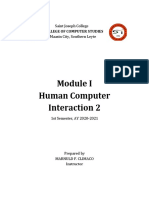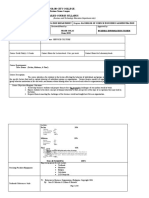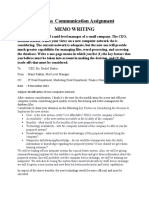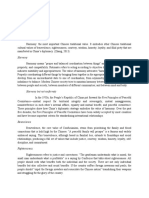Mountain View Community Hospital: Goals and Critical Success Factors
Mountain View Community Hospital: Goals and Critical Success Factors
Uploaded by
fadicool007Copyright:
Available Formats
Mountain View Community Hospital: Goals and Critical Success Factors
Mountain View Community Hospital: Goals and Critical Success Factors
Uploaded by
fadicool007Original Title
Copyright
Available Formats
Share this document
Did you find this document useful?
Is this content inappropriate?
Copyright:
Available Formats
Mountain View Community Hospital: Goals and Critical Success Factors
Mountain View Community Hospital: Goals and Critical Success Factors
Uploaded by
fadicool007Copyright:
Available Formats
Chapter 1 The Database Environment and Development Process 49
CASE
Mountain View Community Hospital
Introduction
This case is included to provide you an opportunity to apply
the concepts and techniques you will learn in each chapter. The
case can also be used to support a semester-long database proj-
ect built throughout the term that results in a complete applica-
tion. We have selected a hospital for this case because it is a type
of organization that is at least somewhat familiar to most per-
sons and because health-care institutions are of such impor-
tance in our society today. A segment of the case is included at
the end of each chapter in this text. Each segment includes a
brief description of the case as it relates to the material in the
chapter followed by questions and exercises related to the mate-
rial. Additional requirements, assignments, and project deliver-
ables are provided in support of a semester project.
Case Description
Mountain View Community Hospital (MVCH) is a not-for-profit,
short-term, acute care general hospital. It is a relatively small hos-
pital, with some 150 beds. Mountain View Community Hospital
strives to meet the needs of a community of about 60,000 with an
annual growth rate of 10 percent, a trend that is expected to con-
tinue since the surrounding area is attracting many retirees. To
serve the health-care needs of this growing community, Mountain
View Community Hospital plans to expand its capacity by adding
another 50 beds over the next five years, and opening a managed
care retirement center with independent apartments and assisted
living facilities. The basic goal is to provide high-quality, cost-
effective health-care services for the surrounding community in a
compassionate, caring, and personalized manner.
Within the last fiscal year, the hospital performed more
than one million laboratory procedures and over 110,000 radiol-
ogy procedures. During that time, the hospital had 9,192 admis-
sions and 112,230 outpatient visits, brought 1,127 babies into the
world, and performed 2,314 inpatient and 1,490 outpatient sur-
geries. Patients who receive outpatient surgeries do not remain
in the hospital overnight. With an average of 2,340 patients a
month, the emergency department experienced approximately
28,200 visits throughout the year. Approximately 30 percent of
the patients admitted to the hospital were first treated in the
emergency room, and about 13 percent of emergency room vis-
its resulted in hospital admission. The hospital employs 740
full-time and 439 part-time personnel, among them 264 full-
time and 176 part-time registered nurses, and 10 full-time and 6
part-time licensed practical nurses. The hospitals active med-
ical staff includes over 250 primary physicians, specialists, and
subspecialists. Volunteers are an integral part of MVCHs cul-
ture and contribute greatly to the well-being of patients and
their families. Approximately 300 volunteers from different
backgrounds and of all ages devote their time, energy, and tal-
ents to many areas of the hospital. They greet visitors and pa-
tients and help them find their way through the hospital, deliv-
er mail and flowers to patient rooms, escort patients, aid staff
with clerical duties, work in the gift shop, assist at community
and fund-raising events, and help out in a host of other areas.
Mountain View Community Hospital provides a number
of key services, including general medical and surgical care,
general intensive care, a cardiology department, open-heart
surgery, a neurology department, pediatric medical and surgi-
cal care, obstetrics, an orthopedics department, oncology, and a
24-hour emergency department. The hospital also offers a wide
range of diagnostic services. Aspecialty service within the neu-
rology department is the recently opened Multiple Sclerosis
(MS) Center, which provides comprehensive and expert care for
patients with multiple sclerosis in order to improve their quali-
ty of life. Using an interdisciplinary team approach, the center
emphasizes all aspects of MS care from diagnosis and treatment
of MS symptoms and secondary complications, to individual
and family counseling, rehabilitation therapy, and social servic-
es. Headed by Dr. Zequida, called Dr. Z by staff and patients,
the MS Center is a member of a consortium of MS centers.
The current organizational chart for Mountain View
Community Hospital is shown in MVCH Figure 1-1. Like most
other general hospitals, Mountain View Community is divided
into two primary organizational groups. The physicians,
headed by Dr. Browne (chief of staff), are responsible for the
quality of medical care provided to their patients. The group
headed by Ms. Baker (CEO and president) provides the nurs-
ing, clinical, and administrative support the physicians need
to serve their patients. According to Ms. Baker, the most press-
ing issues affecting the hospital within the last year have been
financial challenges such as bad debt, personnel shortages
(particularly registered nurses and imaging technicians), and
malpractice insurance. Other critical issues are the quality of
care, patient safety, compliance with HIPAA, and technologi-
cal innovation, which is seen as a major enabler for decreasing
costs and improving quality. The trend toward managed care
and the need to maintain costs while maintaining/improving
clinical outcomes requires the hospital to track and analyze
both clinical and financial data related to patient care services.
Goals and Critical Success Factors
In response to the steady growth and expansion plans at
Mountain View Community Hospital, a special study team in-
cluding Mr. Heller, Mr. Lopez, Dr. Jefferson, and a consultant
has been developing a long-term strategic plan, including an in-
formation systems plan for the hospital. Their work is not com-
plete, but they have begun to identify many of the elements nec-
essary to build the plan. To meet the goals of high-quality health
care, cost containment, and expansion into new services, the
team concluded that the hospital has four critical success factors
(CSFs): quality of medical care, control of operating costs, con-
trol of capital costs, and recruitment and retention of skilled
personnel. The development of improved information systems
is viewed as an enabler in dealing with each of these CSFs.
The team is currently at work to generate two to four
short- or long-term objectives for each CSF. So far they have
developed the following four objectives related to the control of
the operating costs CSF:
1. Reduce costs for purchased items
2. More efficiently schedule staff
3. Lower cost of liability insurance
4. Expand volunteer services
50 Part I The Context of Database Management
The study team has developed a preliminary list of busi-
ness functions that describe the administrative and medical
activities within the hospital. These functions consider the or-
ganizational goals and CSFs explained in the prior section. At
this point, the study team has identified five major business
functions that cut across all of the organizational units:
1. Patient care administration Manage the logistical and
record-keeping aspects of patient care
2. Clinical services Provide laboratory testing and proce-
dures, and patient monitoring and screening
3. Patient care services Provide patients with medical care
and support services
4. Financial management Manage the financial resources
and operations of the hospital
5. Administrative services Provide general management
and support services not directly related to patient care
The study team has been able to break each of these high-
level business functions into lists of more detailed functions
(see MVCH Figure 1-2), but the team knows that these lists are
not complete nor well defined at this point.
Mountain View Community Hospital has computer
applications that support the following areas (among others):
patient care administration, clinical services, financial manage-
ment, and administrative services. Many of these applications
have been purchased from outside vendors, but a few have
been developed internally. Most of the computer applications
are implemented using relational database and client/server
technology. In the client/server environment, the client runs
the database applications that request the data. The server runs
the DBMS software, which fulfills the requests and handles the
functions required for concurrent, shared data access to the
database. Most of the databases (as well as the applications) are
two tier, using the classification introduced in this chapter.
Patient care Patient care Financial Administrative
administration Clinical services services management services
Patient scheduling
Patient registration
Admit patient
Assign patient to bed
Transfer patient
Discharge patient
Physician orders
Laboratory reporting
Electrodiagnosis
Psychiatric testing
Patient monitoring
Multiphasic screening
Radiology
Perform X-rays
Laboratory
Perform blood tests
Dietary/Nutrition
Nursing Surgery
Rehabilitation
Perform physical therapy
Blood banking
Patient accounting
Bill patient
Account for receivables
Cost accounting
Payroll
General accounting
Risk management
Purchasing
Inventory control
Housekeeping
Personnel
Volunteering
Recruit volunteers
Schedule volunteers
Evaluate volunteers
MVCH FIGURE 1-2 Business functions
Board of Directors
Ms. Baker
CEO
Dr. Browne
Chief of Staff
Ms. Price
VP
Clinical Services
Mr. Heller
CIO
Mr. Thomas
Spiritual Care
Mr. Lopez
Chief
Financial Officer
Ms. Alvarez
Accounting
Ms. Baddeck
Chief Administrative
Officer
Mr. Davis
Volunteer
Services
Mr. Clay
Admissions &
Patient Accounts
Ms. Crowley
Assistant
Dr. Redfern
Chief of Medicine
Dr. Jefferson
Chief of Surgery
Ms. Stevens
Personnel
Ms. Knight
Chief Nursing
Officer
MVCH FIGURE 1-1 Organizational chart
www.itpub.net
Chapter 1 The Database Environment and Development Process 51
Enterprise Modeling
The study team identified a preliminary set of 11 entity types
that describe the data required by the hospital in support of the
various business functions: FACILITY, PHYSICIAN, PATIENT,
DIAGNOSTIC UNIT, WARD, STAFF, ORDER, SERVICE/DRUG,
MEDICAL/SURGICAL ITEM, SUPPLY ITEM, and VENDOR.
From discussions with hospital staff, reviewing hospital docu-
ments, and studying existing information systems, the study
team developed a list of business rules describing the policies of
the hospital and nature of the hospitals operation that govern
the relationships between these entities. Some of these rules are:
1. AFACILITY maintains one or more DIAGNOSTIC UNITS
(radiology, clinical laboratory, cardiac diagnostic unit, etc.).
2. AFACILITYcontains a number of WARDs (obstetrics, on-
cology, geriatrics, etc.).
3. Each WARD is assigned a certain number of STAFF mem-
bers (nurses, secretaries, etc.); a STAFF member may be
assigned to multiple WARDs.
4. A FACILITY staffs its medical team with a number of
PHYSICIANs. APHYSICIAN may be on the staff of more
than one FACILITY.
5. APHYSICIAN treats PATIENTs, and a PATIENT is treat-
ed by any number of PHYSICIANs.
6. A PHYSICIAN diagnoses PATIENTs, and a PATIENT is
diagnosed by any number of PHYSICIANs.
7. A PATIENT may be assigned to a WARD (outpatients are
not assigned to a WARD). The hospital cares only about the
current WARD a patient is assigned to (if assigned at all).
8. A PATIENT uses MEDICAL/SURGICAL ITEMS, which
are supplied by VENDORs. A VENDOR also provides
SUPPLY ITEMs that are used for housekeeping and main-
tenance purposes.
9. A PHYSICIAN writes one or more ORDERS for a PA-
TIENT. Each ORDER is for a given PATIENT, and a PA-
TIENT may have many ORDERs.
10. An ORDER can be for a diagnostic test (lab tests such as
lipid profile, CBC, liver function tests; diagnostic imaging
such as MRIs and X-rays) or a drug.
They recognized that certain business functions, such as
risk management and volunteering, were not adequately repre-
sented in the set of data entities and business rules, but they de-
cided to deal with these and other areas later. The study team
stored descriptions of these data entities and the business rules
in the CASE repository for later analysis. Using the identified
entities and business rules, the study team developed a prelim-
inary enterprise data model (see MVCH Figure 1-3). Again, this
conceptual model is preliminary and does not follow all the
conventions used in the information systems department for
drawing data models, but the purpose of this enterprise model
is to give only a general overview of organizational data.
Case Questions
1. The goal of Mountain View Community Hospital is to pro-
vide high-quality, cost-effective health-care services for the
surrounding community in a compassionate, caring, and
personalized manner. Give some examples of how the use
of databases in the hospital might improve health-care
quality or contain costs. How else could a well-managed
database help the hospital achieve its mission?
2. How can database technology be used to help Mountain
View Community Hospital comply with the security stan-
dards of the Health Insurance Portability and
Accountability Act of 1996 (HIPAA)? HIPAA requires
health-care providers to maintain reasonable and appropri-
ate administrative, technical, and physical safeguards to
ensure that the integrity, confidentiality, and availability of
electronic health information they collect, maintain, use, or
transmit is protected. (For more details on HIPAA, visit
www.hhs.gov/ocr/privacy.)
3. What are some of the costs and risks of using databases
that the hospital must manage carefully?
4. How critical are data quality requirements in the hospital
environment? For which applications might quality re-
quirements be more restrictive?
5. At present, Mountain View Community Hospital is using
relational database technology. Although this technology is
Is Assigned To
Uses
FACILITY
WARD
Contains
PHYSICIAN
PATIENT
MEDICAL/
SURGICAL
ITEM
STAFF
SUPPLY
ITEM
VENDOR
ORDER
TEST/
DRUG
Diagnoses Treats
Staffs
Is For
Is Written By
Works At
Is Provided
By
Is Supplied By
Is Given To
MVCH FIGURE 1-3 Preliminary
enterprise data model
52 Part I The Context of Database Management
appropriate for structured data, such as patient or account-
ing data, it is less well-suited to unstructured data, such as
graphical data and images. Can you think of some types of
data maintained by a hospital that fit this latter category?
What types of database technology rather than relational
might be better suited to these data types?
6. How could the hospital use Web-based applications? What
are some of the benefits and risks associated with Web-
based applications for the hospital?
7. The case description lists 10 business rules. The study team
used these rules to develop MVCH Figure 1-3. Are there
any other business rules implied by or depicted in that fig-
ure? What are they?
Case Exercises
1. The relational databases at Mountain View Community
Hospital contain a number of tables. Two of these tables,
with some sample data, are shown in MVCH Figure 1-4.
The PATIENT table contains data concerning current or re-
cent patients at the hospital, whereas the PATIENT
CHARGES table contains data describing charges that have
been incurred by those patients. Interestingly, the PATIENT
CHARGES table is not captured in the preliminary enter-
prise data model shown in Figure 1-3.
a. Using the notation introduced in this chapter, draw a di-
agram showing the relationship between the entities
PATIENT and PATIENT CHARGES.
b. Develop a metadata chart for the data attributes in the
PATIENT and PATIENT CHARGES tables using (at
minimum) the columns shown in Table 1-1. You may in-
clude other metadata characteristics that you think are
appropriate for the management of data at Mountain
View Community Hospital.
2. One of the important outputs from the bill patient busi-
ness function is the Patient Bill. Following is a highly sim-
plified version of this bill (MVCH Figure 1-5).
a. Using the data from MVCH Figure 1-4, add missing
data that would typically appear on a patient bill.
b. Using your result from part a), verify that the enterprise
data model in MVCH Figure 1-3 contains the data nec-
essary to generate a patient bill. Explain what you have
to do to perform this verification. What did you discov-
er from your analysis?
3. Using the notation introduced in this chapter, draw a single
diagram that represents the following relationships in the
hospital environment.
AHOSPITALhas on its staff one or more PHYSICIANs. A
PHYSICIAN is on the staff of only one HOSPITAL.
APHYSICIAN may admit one or more PATIENTs. APA-
TIENT is admitted by only one PHYSICIAN.
AHOSPITAL has one or more WARDs. Each WARD is lo-
cated in exactly one HOSPITAL.
AWARD has any number of EMPLOYEEs. An EMPLOY-
EE may work in one or more WARDs.
4. Using a DBMS suggested by your instructor, such as
Microsoft Access or SQL Server, you may begin to prototype
a database for Mountain View Community Hospital. Here
are some suggestions to guide you:
a. Develop a metadata chart for an EMPLOYEE table simi-
lar to Table 1-1.
b. What types of relationships (1:1, 1:M, or M:N) are likely to
exist between your PATIENT table and other tables in the
database? How did you determine that?
c. MVCH hospital administrators regularly need informa-
tion about their patient population. Based on the distinc-
tion between data and information discussed in this
PATIENT
Patient Number
8379
4238
3047
5838
6143
Dimas
Dolan
Larreau
Wiggins
Thomas
Patient Last Name
Selena
Mark
Annette
Brian
Wendell
Patient First Name
617 Valley Vista
818 River Run
127 Sandhill
431 Walnut
928 Logan
Patient Address
PATIENT CHARGES
Item Description
Room Semi-Priv
Speech Therapy
Radiology
Physical Therapy
EKG Test
Room Semi-Priv
Standard IV
EEG Test
200
350
275
409
500
200
470
700
Item Code
4238
3047
4238
5838
8379
3047
8379
4238
Patient Number
1600
750
150
600
200
800
150
200
Amount
MVCH FIGURE 1-4 Two
database tables from
Mountain View Community
Hospital
www.itpub.net
Chapter 1 The Database Environment and Development Process 53
chapter, explain why a printout of a PATIENT table will
not satisfy these information needs.
d. Create a report that organizes the data from your PA-
TIENT table to provide hospital administrators with use-
ful information about the patient population at MVCH.
5. Earlier in this chapter, we showed an SQL query that dis-
plays information about computer desks at Pine Valley
Furniture Company:
SELECT *
FROM Product
WHERE ProductDescription=Computer Desk;
Following this example, create an SQL query for your PA-
TIENT table that displays information about the outpatients.
6. The manager of the risk management area, Ms. Jamieson, is
anxious to receive computerized support for her activities.
The hospital is increasingly facing malpractice claims and lit-
igation, and she does not believe she can wait for improved
information services until the information systems and data-
base plans are set. Specifically, Ms. Jamieson wants a system
that will track claims, legal suits, lawyers, judges, medical
staff, disbursements against claims, and judgments. How
would you proceed to deal with this request for improved
information services? What methodology would you apply
to design or acquire the systems and databases she needs?
Why?
7. Consider again the request of the manager of risk manage-
ment from Case Exercise 6. On what tier or tiers would you
recommend the system and database she needs be devel-
oped? Why?
Project Assignments
P1. The study teams activities described in this case study are
still in the very early stages of information system and
database development. Outline the next steps that should
be followed within the Information Systems unit to align
current systems and databases to the future information
systems needs of the hospital.
P2. The patient bill is an example of a view that would be of in-
terest in a hospital environment. Identify and list other user
views that could occur in a hospital environment.
P3. Carefully read through the case description, exercises, and
questions again and:
a. Modify the enterprise data model shown in MVCH
Figure 1-3 to include any additional entities and rela-
tionships that you identify.
b. Modify the list of business rules from the case descrip-
tion to include the additional entities and relationships
you identified.
c. Draw a context diagram of MVCHs improved informa-
tion system similar to the one for a burger restaurant
shown in MVCH Figure 1-6. A context diagram pro-
vides the highest-level view of a system and shows the
system boundaries, external entities that interact with
the system, and major information flows between the
entities and the system.
Patient Name: Dolan, Mark
Patient Number:
Patient Address:
Item Code Item Description Amount
MVCH FIGURE 1-5 Partial
patient bill
Food
Ordering
System
CUSTOMER
Customer Order
RESTAURANT
MANAGER
Management
Reports
Receipt
KITCHEN
Food Order
MVCH FIGURE 1-6 Context
diagram example
Source: Adapted from Hoffer et al.
(2010).
You might also like
- Assignment 6 Chapter 6Document3 pagesAssignment 6 Chapter 6Abeba GselassieNo ratings yet
- Handouts in Business EthicsDocument2 pagesHandouts in Business EthicsAimelenne Jay AninionNo ratings yet
- Umbilical Hernia: Presented byDocument18 pagesUmbilical Hernia: Presented bySuhas IngaleNo ratings yet
- Dobutamine Drug StudyDocument1 pageDobutamine Drug Studyjoella100% (1)
- Sales - and Inventory SystemDocument10 pagesSales - and Inventory SystemJade Jorial LucenaNo ratings yet
- Module Hci 2Document13 pagesModule Hci 2MarnuldClimacoNo ratings yet
- Module 5Document23 pagesModule 5Zakurieh NeriNo ratings yet
- Bsa201 CH02 WRDocument57 pagesBsa201 CH02 WRNicah AcojonNo ratings yet
- CHAPTER 1 E Commerce and Internet MarketingDocument4 pagesCHAPTER 1 E Commerce and Internet MarketingJessica CerezaNo ratings yet
- Project Planning and Management Unit 1Document13 pagesProject Planning and Management Unit 1Savant100% (1)
- Introduction To Logistics Management Module 4Document19 pagesIntroduction To Logistics Management Module 4Kyle SikorskyNo ratings yet
- AdetDocument6 pagesAdetAnjemar AcostaNo ratings yet
- Codechum An Online Learning and Monitoring PlatforDocument11 pagesCodechum An Online Learning and Monitoring PlatforDan WayneNo ratings yet
- Lect1 STS IntroductionDocument44 pagesLect1 STS IntroductionAbegail RafalNo ratings yet
- DM104 - Evaluation of Business PerformanceDocument15 pagesDM104 - Evaluation of Business PerformanceJaysan Ray Ngujo CheeNo ratings yet
- Module 7 Communication For Academic PurposesDocument50 pagesModule 7 Communication For Academic PurposesJoksian TrapelaNo ratings yet
- Illicit Financial Flows To and From The Philippines: A Study in Dynamic Simulation, 1960-2011Document56 pagesIllicit Financial Flows To and From The Philippines: A Study in Dynamic Simulation, 1960-2011Global Financial IntegrityNo ratings yet
- Reporter: Pangan, Carolina FDocument4 pagesReporter: Pangan, Carolina FCarol Ferreros PanganNo ratings yet
- Queuing and Service Management System With SMS Notification in Southern Leyte State University - College of Agriculture, Food and Environmental SciencesDocument5 pagesQueuing and Service Management System With SMS Notification in Southern Leyte State University - College of Agriculture, Food and Environmental SciencesInternational Journal of Innovative Science and Research TechnologyNo ratings yet
- StsDocument4 pagesStsSheena TuddaoNo ratings yet
- SERVICE CULTURE EditedDocument20 pagesSERVICE CULTURE EditedGeve LibertadNo ratings yet
- The Objectives and Functions of Operating Systems: Student - Feedback@sti - EduDocument5 pagesThe Objectives and Functions of Operating Systems: Student - Feedback@sti - Edunew genshinNo ratings yet
- MGT 406 - Chapter 1Document18 pagesMGT 406 - Chapter 1Bilal AfzalNo ratings yet
- SF GE101 Module3 4 - v.1Document4 pagesSF GE101 Module3 4 - v.1Ica Mae100% (1)
- Oact40013 - Business Office Systems and Technologies 1Document88 pagesOact40013 - Business Office Systems and Technologies 1ambasgracefatimapNo ratings yet
- Database Management SystemDocument2 pagesDatabase Management SystemSK LashariNo ratings yet
- 1.2 Computer Hardware Review 1.3 Operating System ConceptsDocument98 pages1.2 Computer Hardware Review 1.3 Operating System ConceptsDo Cao Dat (K15 HL)No ratings yet
- Office MangementDocument114 pagesOffice MangementRohitkumaran Maran100% (1)
- PSG Module 7Document30 pagesPSG Module 7Deepak KumarNo ratings yet
- Importance of Physical Fitness in HumanDocument4 pagesImportance of Physical Fitness in HumanIshika Mathur100% (1)
- Chapter Four Developing Business PlanDocument30 pagesChapter Four Developing Business PlanReffisa JiruNo ratings yet
- UPS Competes Globally With Information TechnologyDocument3 pagesUPS Competes Globally With Information TechnologyBiweshNo ratings yet
- Feldmans's Art 2Document20 pagesFeldmans's Art 2annagguiles100% (1)
- ICT Applications in SocietyDocument38 pagesICT Applications in Societytanongnichi15No ratings yet
- Capacity Planning ReflectionDocument1 pageCapacity Planning ReflectionErinNo ratings yet
- PPT ch05Document45 pagesPPT ch05Norman RonaldNo ratings yet
- Introduction of Unilever Philippines IncDocument4 pagesIntroduction of Unilever Philippines InclisaNo ratings yet
- NSTP 2 Week 3 ModuleDocument5 pagesNSTP 2 Week 3 ModuleJason RecanaNo ratings yet
- Logical Malleability, Invisibility Factor, Moral ResponsibilitiesDocument3 pagesLogical Malleability, Invisibility Factor, Moral ResponsibilitiesJordan BasiloniaNo ratings yet
- Activity 7.1 - Big History 1 ReviewDocument4 pagesActivity 7.1 - Big History 1 ReviewIvanNo ratings yet
- Quality Costs and Productivity: Measurement, Reporting, and ControlDocument45 pagesQuality Costs and Productivity: Measurement, Reporting, and ControlDhani SardonoNo ratings yet
- Visitor Log and Monitoring SystemDocument7 pagesVisitor Log and Monitoring SystemKarla MaeNo ratings yet
- System Analysis Design Titles and ObjectivesDocument3 pagesSystem Analysis Design Titles and ObjectivesAlmar AlcarasNo ratings yet
- San Beda College Alabang College of LawDocument4 pagesSan Beda College Alabang College of LawByron Jon TulodNo ratings yet
- Business Communication Assignment - MEMODocument2 pagesBusiness Communication Assignment - MEMOmanju kakkarNo ratings yet
- Syllabus Employment and Ethics in The ProfessionDocument7 pagesSyllabus Employment and Ethics in The ProfessionNeil JeresanoNo ratings yet
- What Is The Distinctive Competence of The Followin.Document2 pagesWhat Is The Distinctive Competence of The Followin.farel ayengNo ratings yet
- E MarketingDocument12 pagesE MarketingChaimae Es-salmanyNo ratings yet
- Gepc Module 6 Assessment Answer Sheet - Del GallegoDocument3 pagesGepc Module 6 Assessment Answer Sheet - Del GallegoMaria Angela Del GallegoNo ratings yet
- Select From: 'Customer (' ') :'Document17 pagesSelect From: 'Customer (' ') :'Sakshi GoelNo ratings yet
- The Effect of Synchronous and Asynchronous Participation On Students' Performance in Online Accounting CoursesDocument31 pagesThe Effect of Synchronous and Asynchronous Participation On Students' Performance in Online Accounting CoursesHenry James NepomucenoNo ratings yet
- All About STIDocument3 pagesAll About STIRed MurNo ratings yet
- Strategic Analysis in ActionDocument23 pagesStrategic Analysis in ActionFreddierick JuntillaNo ratings yet
- Reiz - Chapter 8 - Introduction To The Different Functional AreasDocument12 pagesReiz - Chapter 8 - Introduction To The Different Functional AreasrakportalesNo ratings yet
- 8.8 What Is Gene TherapyDocument2 pages8.8 What Is Gene TherapyNarasimha MurthyNo ratings yet
- The Economy and Securities Analysis - Business FinanceDocument45 pagesThe Economy and Securities Analysis - Business FinanceMark Angelo R. Arceo100% (1)
- BA Unidad1Document12 pagesBA Unidad1cmjaramillo-1No ratings yet
- QUESTION: With Relevant Examples, Explain The Product Development Stages. SolutionDocument11 pagesQUESTION: With Relevant Examples, Explain The Product Development Stages. SolutionKisitu MosesNo ratings yet
- Project Attributes & Characteristics - TaggedDocument15 pagesProject Attributes & Characteristics - Taggedsandesh kalathilNo ratings yet
- Cultural Values of ChinaDocument3 pagesCultural Values of ChinaDaceler MaxionNo ratings yet
- Human Resource PlanningDocument24 pagesHuman Resource PlanningThe Professor100% (1)
- Healthcare HXZEAL2 ZD8Document42 pagesHealthcare HXZEAL2 ZD8FMTech ConsultsNo ratings yet
- Oral PathologyDocument31 pagesOral PathologyAnonymous GyqTkXMwMNo ratings yet
- ECG QuizDocument6 pagesECG QuizIsland Rae100% (1)
- Aspek Laboratorium Autoimmune Liver Disease Update 2022Document25 pagesAspek Laboratorium Autoimmune Liver Disease Update 2022Urkes tegal kotaNo ratings yet
- ICSIDocument7 pagesICSIle sageNo ratings yet
- Schizophrenia and Psychosis: Group 4 Presentation PharmacologyDocument4 pagesSchizophrenia and Psychosis: Group 4 Presentation PharmacologyVon Valentine MhuteNo ratings yet
- Growth and Nutrition in Pediatric Chronic Kidney Disease: Douglas M. SilversteinDocument10 pagesGrowth and Nutrition in Pediatric Chronic Kidney Disease: Douglas M. SilversteinanhiramdhaniNo ratings yet
- (Zybio) Hematology Analyzer Z3Document1 page(Zybio) Hematology Analyzer Z3Tinmb FernandoNo ratings yet
- Antonio Daniele Pinna, Giorgio Ercolani (Eds.) - Abdominal Solid Organ Transplantation - Immunology, Indications, Techniques, and Early Complications-Springer International Publishing (2015)Document443 pagesAntonio Daniele Pinna, Giorgio Ercolani (Eds.) - Abdominal Solid Organ Transplantation - Immunology, Indications, Techniques, and Early Complications-Springer International Publishing (2015)blooom_00No ratings yet
- Treatment of Pylorospasm in Infants 1922Document2 pagesTreatment of Pylorospasm in Infants 1922muradchy321No ratings yet
- Lecture 3 - Preoperative - Nursing Management - 2021-2022Document39 pagesLecture 3 - Preoperative - Nursing Management - 2021-2022عمار عاشورNo ratings yet
- Shiatsu Touch Point MassageDocument2 pagesShiatsu Touch Point MassageAngela100% (1)
- Perioperative Care and Operating Room ManagementDocument5 pagesPerioperative Care and Operating Room ManagementAhmed Abd El AzizNo ratings yet
- 01 Articulos Que FaltanDocument2 pages01 Articulos Que FaltanOscar Adrian VelasquezNo ratings yet
- Cme Hypertensive Disorders in Pregnancy 1Document13 pagesCme Hypertensive Disorders in Pregnancy 1Wan JunNo ratings yet
- BioquimicaDocument2,040 pagesBioquimicaJoao Manoel100% (2)
- Menu Exit: Question Number: 1Document83 pagesMenu Exit: Question Number: 1Moamen HellisNo ratings yet
- Diabetes ProtocolDocument4 pagesDiabetes ProtocolEugen CerevanNo ratings yet
- Geriatric Assessment ToolguideDocument16 pagesGeriatric Assessment ToolguideRoel John Atamosa CasilacNo ratings yet
- Cardiovascular Drugs: Dr. Hazha S. Ameen MSCDocument25 pagesCardiovascular Drugs: Dr. Hazha S. Ameen MSCAhmed MohamadNo ratings yet
- Guidelines On High Alert Medication ManagementDocument158 pagesGuidelines On High Alert Medication ManagementAhmed Alwehaimid100% (2)
- Department of Surgery: Case Presentation Intestinal ObstructionDocument46 pagesDepartment of Surgery: Case Presentation Intestinal Obstructionhadil ayeshNo ratings yet
- Jurnal Yoga Jantung 1Document9 pagesJurnal Yoga Jantung 1Riska ApriliaNo ratings yet
- The Health Care Delivery SystemDocument14 pagesThe Health Care Delivery SystemDolma Tamang100% (1)
- Review of Related Literature and StudiesDocument3 pagesReview of Related Literature and StudiesDANIELLE JOYCE BACSALNo ratings yet
- 2.epidemiology and Diseases TransmissionDocument28 pages2.epidemiology and Diseases TransmissionAnonymous XGE6XwHZNo ratings yet
- Chimaphila Pipsissewa Materia Medica HerbsDocument3 pagesChimaphila Pipsissewa Materia Medica HerbsAlejandra Guerrero100% (1)
- Get Miller s anesthesia Miller PDF ebook with Full Chapters NowDocument59 pagesGet Miller s anesthesia Miller PDF ebook with Full Chapters Nowlanzokementa100% (9)
- Saans CPAP+HFNC Specifications - Mar 2023Document3 pagesSaans CPAP+HFNC Specifications - Mar 2023emailtrinaya30No ratings yet

























































































